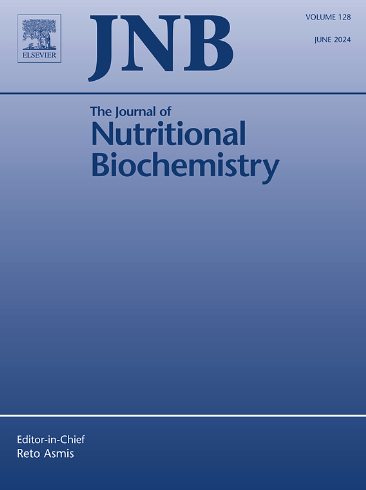Tetrahydrocurcumin ameliorates metabolic disorders associated with obesity by regulating gut microbiota homeostasis
IF 4.9
2区 医学
Q1 BIOCHEMISTRY & MOLECULAR BIOLOGY
引用次数: 0
Abstract
Obesity, a global health crisis, demands novel therapeutic strategies. Tetrahydrocurcumin (THC), a natural compound, shows promise in mitigating obesity by regulating gut microbiota and lipid metabolism. Using in vitro (Hepa1-6 cells) and in vivo (C. elegans and HFD C57BL/6 J mice) models, we evaluated THC’s effects on lipid accumulation, oxidative stress, and key metabolic markers. In glucose-induced obese C. elegans, THC reduced lipid deposition and enhanced antioxidant capacity. In HFD mice, THC improved hepatic function (reduced AST/ALT), decreased liver fat content, and lowered oxidative stress. Mechanistically, THC downregulated Stearoyl-CoA desaturase-1 (SCD1) and Diacylglycerol O acyltransferase 1 (DGAT1) expression (Western blot/RT-qPCR), pivotal regulators of lipid metabolism. Fecal 16S rRNA sequencing revealed THC-modulated gut microbiota, including reduced Firmicutes/Bacteroidetes ratio and Desulfobacterota abundance, alongside elevated short-chain fatty acids (SCFAs). In vitro, THC suppressed lipid accumulation in Hepa1-6 cells. Collectively, THC alleviates obesity by targeting lipid metabolism, oxidative stress, and gut microbial homeostasis, highlighting its therapeutic potential.
四氢姜黄素通过调节肠道微生物群稳态改善与肥胖相关的代谢紊乱。
肥胖,一个全球性的健康危机,需要新的治疗策略。四氢姜黄素(THC)是一种天然化合物,有望通过调节肠道微生物群和脂质代谢来减轻肥胖。通过体外(Hepa1-6细胞)和体内(秀丽隐杆线虫和HFD C57BL/6J小鼠)模型,我们评估了四氢大麻酚对脂质积累、氧化应激和关键代谢标志物的影响。在葡萄糖诱导的肥胖秀丽隐杆线虫中,四氢大麻酚减少脂质沉积,增强抗氧化能力。在HFD小鼠中,四氢大麻酚改善肝功能(降低AST/ALT),降低肝脏脂肪含量,降低氧化应激。机制上,四氢大麻酚下调脂质代谢关键调节因子硬脂酰辅酶a去饱和酶1 (SCD1)和二酰基甘油O酰基转移酶1 (DGAT1)的表达(Western blot/RT-qPCR)。粪便16S rRNA测序显示,thc调节了肠道微生物群,包括厚壁菌门/拟杆菌门比例和脱硫菌门丰度的降低,以及短链脂肪酸(SCFAs)的升高。在体外,四氢大麻酚可抑制Hepa1-6细胞的脂质积累。总的来说,四氢大麻酚通过靶向脂质代谢、氧化应激和肠道微生物稳态来减轻肥胖,突出了其治疗潜力。
本文章由计算机程序翻译,如有差异,请以英文原文为准。
求助全文
约1分钟内获得全文
求助全文
来源期刊

Journal of Nutritional Biochemistry
医学-生化与分子生物学
CiteScore
9.50
自引率
3.60%
发文量
237
审稿时长
68 days
期刊介绍:
Devoted to advancements in nutritional sciences, The Journal of Nutritional Biochemistry presents experimental nutrition research as it relates to: biochemistry, molecular biology, toxicology, or physiology.
Rigorous reviews by an international editorial board of distinguished scientists ensure publication of the most current and key research being conducted in nutrition at the cellular, animal and human level. In addition to its monthly features of critical reviews and research articles, The Journal of Nutritional Biochemistry also periodically publishes emerging issues, experimental methods, and other types of articles.
 求助内容:
求助内容: 应助结果提醒方式:
应助结果提醒方式:


